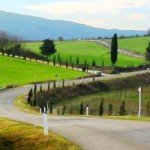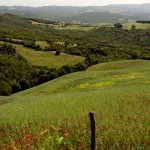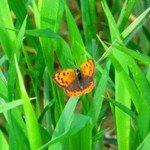The most popular Christmas sweets in Italy are certainly panettone, pandoro and torrone. Even if they have originated in specific areas of the country, they are now part of the national culinary tradition. Thus, panettone is a sort of soft, sweet, leavened bread, with raisins and pieces of candied fruit. Italians do not considered it a type of bread in the strict sense of the term, though: for us, it’s a dessert. The same goes for pandoro, which is said to have been “invented” in Verona. It is similar to both panettone (but without raisins and candied fruit) and brioche and it is served dusted with vanilla scented icing sugar. Torrone is a nougat confection, typically made of honey, sugar, and egg white, with toasted almonds or other nuts, and usually shaped into a rectangular tablet.
In Tuscany, though, as in any other region, we also have local traditional Christmas sweets, the most popular of which are from the Siena area, so we are lucky enough to be able to buy them fresh in bakeries, being so close to the city as we are. Ricciarelli, cavallucci and panforte are the real flavours of the holidays for me. When you enter the bakery and smell the freshly baked ricciarelli and panforti, that is when Christmas has really arrived!
Ricciarelli are made with almond paste. They “are white, soft, spongy-moist, extremely sweet boat- or spindle-shaped almond pastries covered with white confectioner’s sugar, rough in surface and inner texture. Some are covered with dark chocolate called ‘rough’ or ‘rude’: ricciarelli rozzi.” (http://www.turismo.intoscana.it/). They are by large my favourite Christmas dessert. And I don’t care that you can find them all year round: they never taste as good as they do around Christmas, so I never have them outside the holiday season. Judy of Divina Cucina has a good recipe on her website.
Panforte is my dad’s favourite sweet… a panforte rarely lasts more than two days in my parents’ place! Fresh panforte is so much nicer than an industrial one; it hardly compares. “World-famous Sienese panforte is a generic name for four or five varieties of heavy, dense fruit cakes in the form of large wheels. The basic dark, very compact, even hard, chewy body abounds –– according to type –– in candied fruits, almonds, walnuts, and hazel nuts, and in pepper, cinnamon, vanilla and other spices; the top of the ‘wheel’ may be covered in dark chocolate, powdered sugar or white marzipan, whilst the underside is always covered with a white, paper-thin water-and-flour biscuit layer.” (http://wwww.terresiena.it/) A popular variant of the Sienese panforte is panpepato, literally “peppered bread”. It contains many more spices, it’s darker and it’s covered in pepper.
Both ricciarelli and panforte are easy to find throughout Italy (although probably not freshly-baked), but cavallucci are still mostly available only locally. “A cavalluccio –– literally, “small horse” –– is a coarse, massive biscuit, off-white in colour, spongy but compact, tasting of walnuts, anise and candied fruit.” (http://wwww.terresiena.it/) They are generally already rock hard an hour after being taking out of the oven. A secret… if you put them in the microwave for 10-15 seconds before eating them, they are fabulous!
There are many other less popular, or “widespread” Christmas sweets in Tuscany. One is the “mandorlata di Montalcino“, an almond-based thick cake (mandorla means almond), which is a softer alternative to the more well-known panforte. Siena is also home of the copate senesi. They consist in two round layers of thin wafer containing a walnut-based filling similar to what we call “croccante”, sugar and nuts hardbake, with honey and anise.
Pitigliano celebrates Christmas with the “sfratti“. They are shaped like a stick and consist of a layer of pastry filled with a mix made of honey, candied orange, walnuts and nutmeg. Their name derives from their shape. Sfratto means eviction, and the shape of these sweets recalls the batons used by the grand-ducal soldiers to knock on the doors of the homes of the Jews living in Pitagliano in order to serve eviction notices.
In Versilia, befanini are very popular around Christmas time and are the biscuits traditionally served for breakfast on the Epiphany day (January 6th), also known as “La Befana”. La Befana is an old woman, sort of a good witch, who delivers presents to the good children by leaving them in stockings hung by the fireplace. For the naughty kids, she only leaves garlic and coal (even if nowadays, it’s generally sugar coal!). Befanini are simple biscuits shaped as stars, hearts or animals and covered in colourful sugar candies. Pistoia and surroundings have brigidini. They look like chips, but they are sweets made with flour, eggs and anisette. They are very popular at all the fairs and festivals.
If you know of Christmas sweets typical of other areas of Tuscany which are not on my list, please leave a comment! Thank you!!
And if you are looking to spend Christmas in Tuscany, you should take a look at our friends’ properties Casa Gigliola and Il Passo degli Ulivi. Lovely places, where you can spend amazing holidays. The owners are great and they share our philosophy about hospitality.














Since Judy is too modest to add a couple of other links to her site, I will do that for her! Thank you for letting me, Judy! Your site is incredible!
She has a recipe for panforte too, and for some delicious Christmas cookies. Enjoy her recipes! And if you are looking for a great Tuscan cookbook, look no further:
Secrets of my Tuscan Kitchen – Divina Cucina recipes for the home kitchen.
In Vecchiano where I live the days before “La Befana” we prepare ourselfs brigidini (here named “ce’alini”). We eat them on the Epiphany day with our family and we gift them to relatives from other villages!!
Oh, how I’ve enjoyed reading this, even if I’m a year late! Will look up Judy’s recipes and maybe see if Santa will bring me her cookbook. 🙂